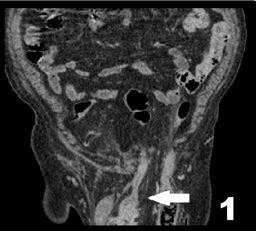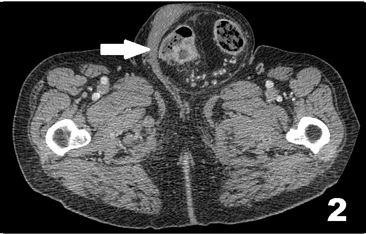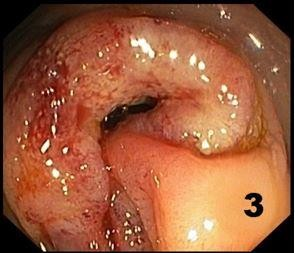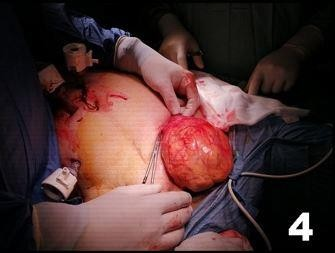Luciano Onofrio1, Danilo Cafaro2, Lorenzo Asciore1, Maria Diana Fidanza1, Francesco Iarrobino1, Gianfausto Iarrobino1
1Department of General, Oncological and Laparoscopic Surgery, Civil Hospital AGP Piedimonte Matese, Via Matese 1-81016, Italy
2Proctology Surgery, Tropea Hospital, Vibo Valentia, Italy
*Corresponding Author: Luciano Onofrio, Department of General, Oncological and Laparoscopic Surgery, Civil Hospital AGP Piedimonte Matese, Via Matese 1-81016, Italy; Email: [email protected]
Published On: 23-02-2022
Copyright© 2022 by Onofrio L, et al. All rights reserved. This is an open access article distributed under the terms of the Creative Commons Attribution License, which permits unrestricted use, distribution and reproduction in any medium, provided the original author and source are credited.
Abstract
Inguinal hernia and colorectal cancer, considered individually, are very common pathologies; their simultaneous manifestation in the same patient, on the other hand, is a rare condition and even more the presentation in the form of a complication (bleeding, intestinal obstruction, etc.). We report an 86-year-old man case of incarcerated sigmoid colon carcinoma diagnosed in the emergency department preoperatively and treated with elective laparoscopic surgery, combined with an inguinal approach. Literature review (last 30 years) was applied to analyzed variability and open questions in the management of this particular pathologic combination.
Keywords
Inguinal Hernia; Sigmoid Carcinoma; Colon Carcinoma; Incarceration
Case Report
A 86-year-old man, with no relevant medical history (except for a radical prostatectomy performed 18 years before), was admitted to the emergency department with a 7-day history of abdominal pain, dis-canalization and weakness, weight loss (5 kg in the last 10 months) was present too. Physical examination revealed only a large, not tender, not reducible mass in the left groin. The patient had a left irreducible inguinal hernia for long time, but on this occasion no pain nor other associated symptoms were represented. Blood testing revealed a leukocyte count of 14.0 × 109/L and a hemoglobin value of 12.2 g/L. TC scan showed a left giant inguinoscrotal hernia containing large bowel, with asymmetric wall thickening and luminal alterations, suggesting a neoplasm within the inguinal hernia. Colonoscopy revealed a stenotic tumor in the sigmoid colon (Fig. 1-3).
The patient underwent elective surgery. A laparoscopic approach was chosen, a common choice in our operating unit when faced with a case of colonic neoplasia without clear evidence of extra-organ invasion.
A Laparoscopic left hemicolectomy was performed. In lithotomy position, under general anesthesia, an 11-mm trocar was inserted below the umbilicus (for a 30-degree camera). 11- mm trocars were inserted at the right upper abdomen and the right lower abdomen. The operator and a camera assistant were on the right side of the patient, the first assistant was positioned on the left side.
Significant stages of surgery include colo-epiploic detachment, which started from the middle of the transverse colon up to the splenic flexure, recognition of the Treitz and the inferior mesenteric vein, the plane of detachment between the Gerota and the lamina of Toldt was identified: at this point that the two bands are joined and more easily recognizable in their dissection. Following the mesenteric cord (proceed in a medium-lateral direction, from top to bottom), until the inferior mesenteric artery is clearly identified, freed from the peri-arterial lymphatic tissue and sectioned between clips. This section allows to proceed with the preparation of the Gerota up to the left parietocolic wall laterally and up to the sacral concavity at the bottom.
After having mobilized all the Gerota laterally and downwards, the upper edge of the mesenteric vein is returned. The lower edge of the pancreas is identified and the mesocolon is detached from the upper edge of the pancreas until it enters the retrocavity of the epiplons. Once the mesocolon has been freed from the pancreas, the section of the mesenteric vein is moved between clips and the mobilization of the colon from the left parietocolic shower up to below the promontory of the sacrum. At this point left descending and sigmoid colon had been separated and free from the retroperitoneum; traction was applied to reduce the distal sigmoid colon into the abdominal cavity (from the inguinal hernia sac). After unsuccessful attempts, a left standard inguinal incision was made (Fig. 4). Using this approach the sigmoid colon (dolicosigma) was completely identified and carcinoma recognized in the hernia sac. The sigmoid colon dissection from the hernia sac was performed, finally the sac of the inguinal hernia was incised and opened, at the internal inguinal ring (external oblique hernia). Now the sigmoid colon could easily be pulled downward, crossing the inguinal ring unhindered. Resection was performed (by a mechanical powered stapler) and the proximal sigmoid colon were end -to- side anastomosed by a circular stapler. Colon was finally reduced in the abdomen; inguinal hernia was repaired with synthetic mesh according to the Lichtenstein technique.
The patient recovered without complication and left the hospital on postoperative day 9. Pathological examination of the tumor revealed a well-differentiated adenocarcinoma, with sub-mucosal invasion through the muscularis mucosa. Nine, no-pathological, lymph nodes were discovered.

Figure 1: TC scan: Hernia.

Figure 2: TC scan: tumor in the sigmoid colon.

Figure 3: Colonoscopy: neoplastic stenosis.

Figure 4: Surgery: laparoscopic + inguinal approach.
Discussion
Inguinal hernia and colorectal cancer are, singularly, very frequent pathologies, on the other hand, their presentation, in the form of a complication, in the same patient and at the same time is rare, about 40 cases are present in literature [6].This disease was more common among elderly population and frequently involved the sigmoid colon, the causes are due to the relevant frequency of colorectal cancer in the population and to high frequency of sigmoid colon in the hernia sac, for its anatomy. The inguinal hernia was predominant in the left side and generally sigmoidectomy with colostomy is the most frequent surgical option, frequently without using artificial materials for inguinal hernia repair [5,6].
Chronic inflammation of the herniated bowel and circulatory distress were considered as possible causes of correlation between inguinal hernia and colon cancer in the past; but no significant association was found so direct correlation between these two pathologies is considered implausible [8,9,10].
In Most cases of inguinal hernia the history and physical examination are usually sufficient to make the diagnosis. Although imaging is rarely necessary, ultrasonography or TC/MR scan can help diagnose a hernia in specific cases, such as athlete without a palpable impulse or bulge on physical examination, or in complicated cases (as in our particular case), in which a physical examination have a limited part in detecting etiology, extent and environment. Moreover imaging is necessary when differential diagnosis/complications need to be focalized for a correct surgical approach.
Even if the first presentation of the patient was in the emergency department, the lack of a condition of surgical emergence has permitted the surgical approach to be postponed, allowing for an accurate pre-operative study including radiological and endoscopic investigations. A colonoscopy completed the pre-op staging; a virtual TC colonoscopy was necessary due to the neoplastic stenosis which did not allow exploration of the entire colon by standard colonoscopy, in order to exclude other synchronous colon cancer, possibly upstream of the stenotic tract.
This condition (lack of surgical emergence) gave the chance of a convinced laparoscopic approach too. Laparoscopy allowed a precise diagnostic classification as well as a correct surgical treatment, not linked to a laparotomy and with the possibility of being remodelled if necessary.
As regards oncological valuation, it should be considered that often these are incidental diagnoses that are presented directly to the operating table and therefore preclude a preliminary oncological assessment and even if such an evaluation were sometimes feasible in the pre- operative evaluation, the advanced age of presentation and co-morbidities would make a neoadjuvant chemotherapy approach contraindicated in most cases [11,12].
Even if faced with a rare pathological combination, a comparison with the data in the literature is always appropriate. As mentioned, since 1938 to date, less than 50 cases have been described (including our current case), of which it is useful to consider above all the type of surgical approach and the methods of treatment of the hernial defect. Made the necessary premise that the surgical approach used must be considered also and above all in the light of the different clinical conditions (Fig. 5) and epoch of presentation [4,6,13].
Considering the treatment and the evolution of surgical procedures over the years, literature cases recorded in the last 30 years have been taken into consideration (22 cases; Table 1)[14- 17] . Looking at these data, Hartmann’s procedure is the most common (54%), the most used surgical approach in complicated cases, only Ruiz-Tovar and Diao opted for direct anastomosis, even in the presence of a perforation, without however reporting relevant post- operative complications [18,26]. The Laparoscopic approach was performed in 23% of (most recent) cases, no relevant complications were presented. Chern performed colectomy and hernioplasty in a unique laparoscopic approach [6]. The open approach was performed in 23% of cases. The analysis of these data also confirms there is no evidence to support a certain approach in elective surgery: the choice of the abdominal (open or laparoscopic) versus inguinal approach will depend on the patient’s anatomy, the surgical findings and the surgeon’s experience [25,28].
On the other hand, the evidence that emerged from recent meta-analyzes about the benefits of laparoscopic hemicolectomy (vs open right hemicolectomy in non-emergent cases in reduction of:
- Post-operative pain
- Blood loss
- Time to first flatus
- Length of hospital stay
Associated with similar results from an oncological point of view:
- Number of lymph nodes removed
- Size of resection
- Recurrence’s rate
It marries our conviction about the validity of the laparoscopic approach and its use when possible and whether it represents an approach routinely used [29,30].
Finally, the surgical approach to inguinal hernia should be considered. In this ambit the main question is whether to use a mesh repairs technique in the restore of the hernial defect. The answer coming from this series examination is non-mesh repairs in most cases (73%); mesh repairs approach (six cases) have been performed in low risk sepsis cases. In the case reported by Ruiz-Tovar, there was perforation without contamination; he performed a mesh repair approach, no complications were reported [18]. Obviously, the main problem here is the risk of mesh infection, 11 surgeons have chosen to perform open hernioplasty without mesh; 2 surgeons opted for intra-abdominal defect closures with the same modality [18].
In Our opinion using a mesh repairs technique is feasible and at a low risk of septic complications in evidence of any abdominal contamination; while us consider TAPP approach to be impracticable for the risk of infection. Dissected peritoneum, in TAPP procedure, is the only wall between mesh and bowel, definitely too thin a barrier to counter the infectious risk.
The original strategy was the one used by Kouraklis who applied a two-stage procedure: in the first time he had created a loop colostomy; in the second operation, delayed 6 weeks, he performed a mesh repair during colostomy closure operation [16].
Author- Year | Age | Site | Complications | Colon Cancer Treatment | Hernia Treatment |
Hale (1991) [14] | 85 | Sigmoid | Incarceration | Hartmann’s | Intra-abdominal internal ring Closure |
Tan (2003) [15] | 62 | Sigmoid | Incarceration | High anterior resection + left orchidectomy | intra-abdominal internal ring closure |
Kouraklis (2003) [16] | 79 | Sigmoid | Perforation | Hartmann’s + loop colostomy | Left open hernioplasty |
Cervinka (2003) [17] | 69 | Sigmoid | Incarceration | Sigmoidectomy + anastomosis + defunctioning transverse colostomy | herniorrhaphy (Bassini) |
Sakorafas (2008) [31] | 85 | Sigmoid | Perforation | Hartmann’s | herniorrhaphy (Bassini) |
Slater (2008) [4] | 66 | Sigmoid | Incarceration | Hartmann’s + left orchidectomy | internal ring closure |
Slater (2008) [4] | 73 | Sigmoid | Perforation | Hartmann’s + left orchidectomy internal ring closure | internal ring closure |
Ruiz-Tovar (2009) [18] | 67 | Sigmoid | Perforation without contamination | Sigmoidectomy and anastomosis | hernioplasty (Lichtenstein) |
Ko (2010) [19] | 84 | Sigmoid | Perforation | Hartmann’s | Herniorrhaphy |
Mai (2010) [20] | 83 | Sigmoid | Strangulation | Hartmann’s | Herniorrhaphy |
Pernazza (2011) [21] | 70 | Caecum | Incarceration | Laparoscopic right hemicolectomy | Herniorrhaphy |
Carr (2012) [22] | 65 | Sigmoid | Incarceration | Laparoscopic high anterior resection | open biosynthetic hernioplasty |
Meniconi (2013) [23] | 78 | Caecum | Incarceration | Open right hemicolectomy | Herniorrhaphy |
Tan (2013) [24] | 63 | Sigmoid | Perforation | Hartmann’s | Herniorrhaphy |
Kanemura (2014) [32] | 67 | Sigmoid | Incarceration | Laparoscopic sigmoidectomy | Herniorrhaphy |
Table 1: Bowel cancer within inguinal hernia 1990-2020.
Conclusion
The rarity of this pathological association (inguinal hernia – colon cancer) cannot be separated from a correct diagnostic setting, even in emergency conditions, even and above all in the face of common pathologies such as inguinal hernia, search for possible symptoms relative to an equally frequent pathology such as colorectal cancer. A correct diagnosis generally translates into a correct surgical approach and a significant limitation of possible complications.
Finally, considering the average age and poor general conditions of patients, it should always be prudence (rather than recklessness) to guide surgical choices, for the awareness that a septic complication would be much more deleterious than a two-stage operation.
Conflict of Interest
It is stated that there are no conflicts of interest.
Authors’ Contributions
- Luciano Onofrio: conceived the original idea, wrote the
- Danilo Cafaro: developed the theoretical
- Lorenzo Asciore, Maria Diana Fidanza: performed the analytic calculations and performed the numerical
- Francesco Iarrobino, Gianfausto Iarrobino: contributed to the final version of the manuscript.
References
- Jin C, Shen Y, Chen J, Chen F, Liu M, Wang F, et Surgery for incarcerated inguinal hernia: Outcomes with Lichtenstein versus open preperitoneal approach. Int J Abdom Wall Hernia Surg. 2019;2:44-9.
- Kuipers EJ, Grady WM, Lieberman D, Seufferlein T, Sung JJ, Boelens PG, et Colorectal Cancer. Nat Rev Dis Primers. 2015;1:15065.
- Yoell, Surprises in hernial sacs-Diagnosis of tumors by microscopic examination. Calif. Med. 1959;91:146.
- Slater R, Amatya U, Shorthouse AJ. Colonic carcinoma presenting as strangulated inguinal hernia: report of two cases and review of the literature. Tech 2008;12(3):255-8.
- Kanemura T, Takeno A, Tamura Elective laparoscopic surgery for sigmoid colon carcinoma incarcerated within an inguinal hernia: report of a case. Surg Today. 2014;44(7):1375-9.
- Chern TY, Tay YK, Perera A rare case of ascending colon adenocarcinoma incarcerated in an inguinoscrotal hernia: case report and literature review. Surgical Case Rep. 2018;4(1):1-6.
- Korn O, Moyano L, Cabello R, Csendes Hallazgo incidental de cáncer en saco herniario inguinal. Revista Médica De Chile. 2002;130(1):91-3.
- Roslyn JJ, Stabile BE, Rangenath Cancer in inguinal and femoral hernias. Am Surg. 1980;46(6):358-62.
- Pernazza G, Monsellato I, Alfano G, Bascone B, Felicioni F, Ferrari R, et al. Laparoscopic treatment of a carcinoma of the cecum incarcerated in a right groin hernia: report of a Surg Today. 2011;41(3):422-5.
- Avidan B, Sonnenberg A, Bhatia H, Aranha G, Schnell TG, Sontag Inguinal hernia is not a sign of colon cancer: results of a prospective screening trial. Aliment Pharmacol Therap. 2002;16(6):1197-201.
- Jessup JM, Stewart A, Greene FL, Minsky Adjuvant chemotherapy for stage III colon cancer:Implications of race/ethnicity, age and differentiation. J Am Med Assoc. 2005;294:2703-11.
- Fata F, Mirza A, Craig Wood G, Nair S, Law A, Gallagher J, et al. Efficacy and toxicityof adjuvant chemotherapy in elderly patients with colon carcinoma: A 10-year experience of the Geisinger Medical Cancer. 2002;94:1931-8.
- Matsumoto G, Ise H, Inoue H, Ogawa H, Suzuki N, Matsuno S. Metastaticcolon carcinoma found within an inguinal hernia sac: report of a case. Surg 2000;30(1):74-7.
- Hale DA, Solla JA. Complete colonic obstruction caused by a sigmoid colon cancer incarcerated in an inguinal hernia sac. South Med 1991;84(10):1280-1.
- Tan GY, Guy RJ, Eu Obstructing sigmoid cancer with local invasion in an incarcerated inguinal hernia. ANZ J Surg. 2003;73(1-2):80-2.
- Kouraklis G, Kouskos E, Gilnavou A, Raftopoulos J, Karatzas Perforated carcinoma of the sigmoid colon in an incarcerated inguinal hernia: report of a case. Surg Today. 2003;33(9):707-8.
- Cervinka A. Surgical images: soft tissue obstructing colon carcinoma in an irreducible scrotal hernia. Can J 2003;46(5):359-60.
- Ruiz-Tovar J, Ripalda E, Beni R, Nistal J, Monroy C, Carda P. Carcinoma of the sigmoid colon in an incarcerated inguinal Can J Surg. 2009;52(2):E31-2.
- Ko KH, Yu CY, Kao CC, Tsai SH, Huang GS, Chang WC. Perforated sigmoid colon cancer within an irreducible inguinal hernia: a case report. Korean J Radiol. 2010;11(2):231-3.
- Mai CM, Chen CY, Hsu KF, Hsiao CW, Jao SW, Wu CC. Colonic neoplasm in a strangulated inguinal hernia. Rev EspEnferm 2008;102(5):339-41.
- Pernazza G, Monsellato I, Alfano G, Bascone B, Felicioni F, Ferrari R, et al. Laparoscopic treatment of a carcinoma of the cecum incarcerated in a right groin hernia: report of a Surg Today. 2011;41(3):422-5.
- Carr WR, O’Dair G. A laparoscopic high anterior resection for sigmoid cancer with extraction through incarcerated left inguinal hernia repaired with Permacol BMJ Case Rep. 2012;2012.
- Meniconi RL, Vennarecci G, Lepiane P, Laurenzi A, Santoro R, Colasanti M, et al. Locally advanced carcinoma of the cecum presenting as a right inguinal hernia: a case report and review of the J Med Case Rep. 2013;7(206).
- Tan A, Taylor G, Ahmed Perforated sigmoid colon carcinoma in an irreducible inguinoscrotal hernia. Ann R Coll Surg Engl. 2013;95(7):125-6.
- Kulasegaran S, Fernando M, Fraser-Jones B, Hammodat Perforated sigmoid colon carcinoma within a left inguinal hernia with associated necrotising infection. N Z Med J. 2016;129(1431):93-5.
- Diao K, Ghosh Perforated transverse colon cancer presenting as an incarcerated inguinal hernia. Am Surg. 2016;82(11):320-2.
- Sharma Inguinoscrotal herniation of a caecal adenocarcinoma. BMJ Case Rep. 2017.
- D Baldi D, Alfano V, B Punzo B. A rare case of sigmoid colon carcinoma in incarcerated inguinal hernia. 2020;10(2):99.
- Ding J, Liao GQ, Xia Y, Zhang ZM, Liu S, Yan Laparoscopic versus open right hemicolectomy for colon cancer: a meta-analysis. J Laparoendosc Adv Surg Tech. 2013;23(1):8-16.
- Rondelli F, Trastulli S, Avenia N, Schillaci G, Cirocchi R, Gulla N, et al. Is laparoscopic right colectomy more effective than open resection? A meta-analysis of randomized and nonrandomized studies. Color Dis. 2012;14(8):e447-69.
- Sakorafas G H, Peros Obstructing sigmoid cancer in a patient with a large, tender, non-reducible inguinal hernia: the obvious diagnosis is not always the correct one. Eur J Cancer Care (Engl). 2008;17(1):72-3.
- Kanemura T, Takeno A, Tamura S, Okishiro M, Nakahira S, Suzuki R, et al. Elective laparoscopic surgery for sigmoid colon carcinoma incarcerated within an inguinal hernia: report of a Surg Today. 2014;44(7):1375-9.
- Gnaś J, Bulsa M, Czaja-Bulsa J. An irreducible left scrotal hernia containing a sigmoid colon tumor (adenocarcinoma) – Case Report. Int J Surg Case 2014;5(8):491-3.
Article Type
Case Report
Publication History
Received On: 29-01-2022
Accepted On: 16-02-2022
Published On: 23-02-2022
Copyright© 2022 by Onofrio L, et al. All rights reserved. This is an open access article distributed under the terms of the Creative Commons Attribution License, which permits unrestricted use, distribution, and reproduction in any medium, provided the original author and source are credited.
Citation: Onofrio L, et al. Sigmoid Colon Cancer in an Irreducible Scrotal Hernia Case: A Combined Surgical Laparoscopic and Inguinal Approach and Review of the Literature. J Surg Res Prac. 2022;3(1):1-12.

Figure 1: TC scan: Hernia.

Figure 2: TC scan: tumor in the sigmoid colon.

Figure 3: Colonoscopy: neoplastic stenosis.

Figure 4: Surgery: laparoscopic + inguinal approach.


